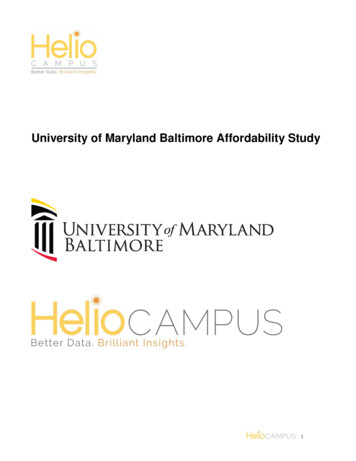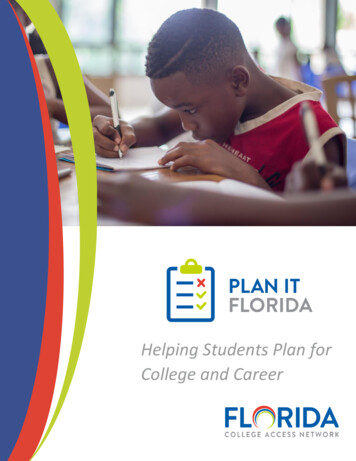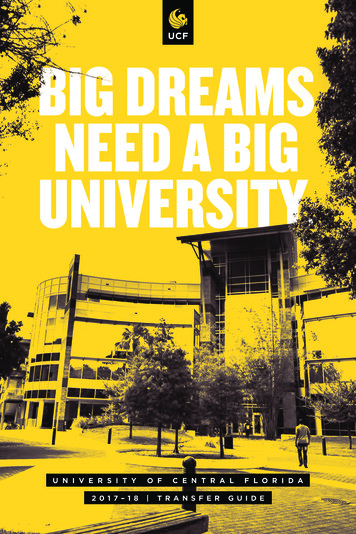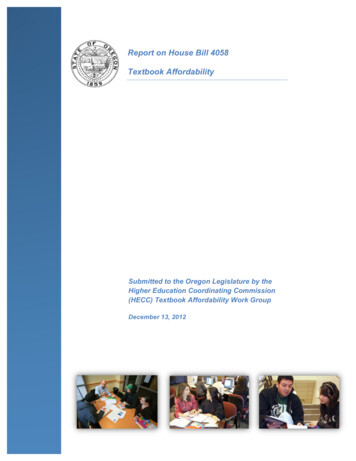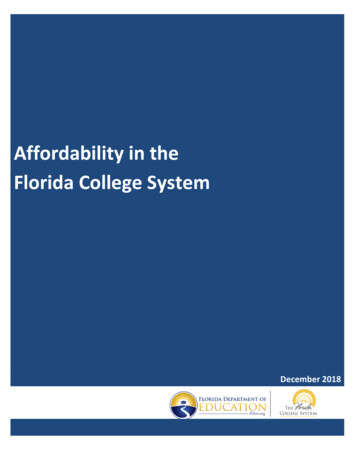
Transcription
Affordability in theFlorida College SystemDecember 2018
AcknowledgementsThe Division of Florida Colleges gratefully acknowledges the contributions of the 28 collegeswithin the Florida College System for their efforts to make educational opportunity a reality andtheir collaboration, which contributed to the creation of this report.Preferred CitationAffordability in the Florida College System (2018). Tallahassee, FL: Florida Department ofEducation, Division of Florida Colleges.Copyright2018 Florida Department of Education, Division of Florida Colleges
Affordability in the Florida College SystemContentsIntroduction . 2Who the Florida College System Serves . 2Stabilizing Tuition and Fees . 3Strategy: Stabilizing Tuition and Fees . 3Reducing/Holding Tuition. . 3Reducing Fees . 3Cost Savings . 4Strategy 1: Offering 2 2 Articulation Agreements and Targeted Pathways . 4Strategy 2: Reducing Time to Graduation . 5Placing Students on Pathways . 5Implementing Developmental Education Reform. 5Expanding Online Offerings. . 6Offering Acceleration Mechanisms . 6Strategy 3: Enhancing Operational Efficiency . 7Reducing Administrative Costs . 7Increasing Efficiencies in Utility Costs . 7Optimizing Space Utilization . 8Outsourcing Services . 8Improving Bidding and Procurement Practices . 8Strategy 4: Evaluating Academic Offerings . 9Aligning Course Demand and Offerings . 9Terminating Programs . 10Expanding 10,000 Bachelor’s Degrees . 10Student Financial Support. 10Strategy: Providing Institutional Student Financial Aid . 11Targeted Financial Aid . 11Emergency Financial Aid. . 11Identifying and Awarding Student Financial Aid. . 11Partnerships to Support Students. . 12Conclusion . 12Page 1 of 12
Affordability in the Florida College SystemIntroductionThe Florida College System is the primary access point to undergraduate education forFloridians, including recent high school graduates and returning adult students. The 28 membercolleges respond quickly and efficiently to meet the demands of employers by aligningcertificate and degree programs with regional workforce needs. With an array of educationalprograms and services, the FCS serves individuals, communities and the state with low-cost,high-quality education opportunities. College access and affordability have been and remainpriorities for all 28 colleges.During the 2016 legislative session, the Florida Legislature tasked the State Board of Educationwith conducting a study to identify strategies and initiatives promoting college affordability by:evaluating the impact of tuition and fees on students; examining federal, state and institutionalfinancial aid on the actual cost of attendance for students and their families; and exploring thecosts of textbooks and instructional materials.Pursuant to section (s.) 1004.084, Florida Statutes (F.S.), this Florida College SystemAffordability Report has been prepared for the governor, the president of the Senate and thespeaker of the House of Representatives.Who the Florida College System ServesData from the Florida Department of Education’s Bureau of PK-20 Education Reporting andAccessibility reflect the 28 colleges of the Florida College System served more than 730,000students in 2017-18. Sixty-three percent (63%) of Florida’s high school graduates who pursuehigher education enroll in a Florida College System institution, and nearly half of the juniors andseniors enrolled in the State University System are graduates of the Florida College System.More than half of students enrolled in the FCS are low income and are the first in their familiesto attend college.Ninety-nine percent (99%) of FCS students are from Florida and the average age of the studentbody is 25. Sixty-five percent of students are enrolled part-time, allowing them to balancecollege and life responsibilities. Nine out of ten Florida College System graduates are employedin Florida or continue their education.Florida College System institutions are recognized as being among the nation’s best colleges.Whether it is through innovations in teaching, advising, transfer or partnerships with businessPage 2 of 12
Affordability in the Florida College Systemand industry, the FCS keeps college affordable. This report provides an overview of thestrategies FCS institutions employ to maintain and increase college affordability.Stabilizing Tuition and FeesFlorida College System institutions keep college affordable for students by maintaining lowtuition and fees. Tuition at Florida College System institutions has remained flat for five yearswhile colleges have implemented strategies that focus on enrollment growth, efficiency andaffordability.Strategy: Stabilizing Tuition and FeesFlorida College System institutions are the most affordably priced option for higher education inFlorida. For 2017-18 full-time enrollment in lower division programs, in-state tuition and feeswere 3,205 per year compared to 5,943 at a state university.Reducing/Holding Tuition. Florida College System institutions did not increase tuition in 201718. Daytona State College approved a two percent reduction in tuition effective spring 2016that is now the standard tuition cost for 2017-18.FCS institutions provide students with options to pay their tuition without taking on debt. Theseoptions may include payment plans, college work-study, grants, scholarships, waivers andtuition reimbursement plans. Florida Keys Community College increased the number ofpayment plan options to assist student’s ability to pay their tuition and avoid high-interestloans. The timing of these plans have been adjusted to allow more students to take advantageof these options.Reducing Fees. FCS institutions regularly review each course fee as required in s. 1009.23, F.S.The purpose of these reviews is to ensure the fees charged do not exceed the cost of providingthe course. Such evaluations may result in the reduction or elimination of student fees. TheCollege of Central Florida recently eliminated 35 student course fees with students saving from 5 to 285 dollars per course, saving 416 students over 78,000. Florida SouthWestern StateCollege (FSW) reduced course fees in 61 courses and eliminated 81 course fees, saving studentsapproximately 610,000. Additionally, FSW reduced the online access fee by 5 per credit hoursaving students 377,510. Tallahassee Community College reduced course fees in 31% ofcourses.Page 3 of 12
Affordability in the Florida College SystemCost SavingsIn addition to investments from the state and students, FCS institutions are able to provide anaffordable college education by operating efficiently. Strategies FCS institutions employ to keepcollege affordable fit within the following areas: 1) offering 2 2 articulation agreements andtargeted pathways; 2) reducing time to graduation; 3) enhancing operational efficiency; and 4)evaluating academic offerings. An additional set of actions regarding textbook affordability aredetailed in the annual Florida College System Textbook and Instructional Materials AffordabilityReport. The 2017-18 report highlights all FCS institutions: Have an adoption process that considers the cost of textbooks and instructionalmaterials.Undertook efforts to meet posting requirements for lists of required and recommendedtextbooks and instructional materials.Employed at least one initiative designed to reduce the cost of textbooks andinstructional materials (e.g., open educational resources, textbook rentals and programswith no textbook or instructional materials costs).Conducted a cost-benefit analysis to select textbooks and materials focused onaffordability and high-quality resources that met the learning outcomes of courses.Notably, for general education core courses, 93 percent of FCS institutions used openeducational resources, which gives students access to textbooks and instructional materials forthese required courses at no or very little costStrategy 1: Offering 2 2 Articulation Agreements and Targeted PathwaysWhen other systems partner with the FCS, students can realize further savings. Most notably isthe vaunted 2 2 articulation agreement in Florida, which guarantees that credits will transferand be applied at the state university. Over 50,000 students who have already earned anassociate in arts degree from a Florida College System institution are enrolled at StateUniversity System (SUS) institutions to continue their education. For these students, theaverage savings is over 5,000 in tuition and fee payments due to lower tuition charges at anFCS institution. The FCS continues to enhance 2 2 programs with targeted pathways, such asUCF DirectConnect, that ensure students have a seamless pathway to completing their degreesat the one of the state universities. In these programs, students who earn their associate in artsdegree at certain FCS institutions are guaranteed admission to a specific state university and/ora specific program of study. All 28 FCS institutions have developed at least one targetedpathway with SUS partners.Page 4 of 12
Affordability in the Florida College SystemStrategy 2: Reducing Time to GraduationStrategies to decrease students’ time to completion provide benefits to students and the state.One such benefit is beginning to earn higher wages earlier while reducing the amount of timepaying for living expenses as a student. To this end, FCS institutions are implementing practicesto reduce the time to completion by placing students on guided pathways.Placing Students on Pathways. The Florida Student Success Center joined as the 15th state inthe national Student Success Center Network, supporting Florida's 28 colleges' efforts todevelop student-centered pathways. The center works collaboratively with colleges to create acoherent, statewide strategy so colleges can integrate their varied student success efforts,share best practices with one another and maximize resources. The guided pathways model isan integrated, institution-wide approach to student success. The model includes fourdimensions: 1) clarify paths to student end goals, 2) help students choose and enter a pathway,3) help students stay on the path and 4) ensure that students are learning. The model isdesigned to simplify students’ choices with maps that are clear, include progress milestonesand are aligned with the student's education and employment field, including transferpathways.This pathway work also results in colleges structuring their institutions to maximize studentsuccess. For example, St. Johns River State College’s Student Success initiative includesproactive advising with integration of faculty mentoring, an early alert system, one-stopstudent services, scheduling, onboarding and online orientation.Broward College has led national efforts in implementing guided pathways that help studentstake only the courses required for completion and/or transfer in a selected career area, whichreduces time and costs to students. Broward College also provides students with informationon job tools and salaries. At Miami Dade College, students have begun using a software tool tohelp make informed career and major decisions by helping develop clear academic plans,understand time to degree completion requirements and communicate with advisors.Tallahassee Community College has installed career coaching kiosks throughout the campus.Career Coach is also available via the college website as well as in the career center. Thesoftware is a free online tool that allows students to explore careers as well as live job postings.The real-time information includes detailed wage estimates and up-to-date job postingsassociated with any career.Implementing Developmental Education Reform. FCS institutions utilize nationally recognized,high-impact practices that enhance student success as well as address the statutorily mandatedPage 5 of 12
Affordability in the Florida College Systemchanges to the populations enrolled in developmental education. For the 2017-18, courseenrollments in developmental education decreased 26 percent from the previous year. Studentsuccess rates— the percent of students who earned a grade of “C” and above— remainedstable with success rates of 75 percent in reading and 73 percent in writing. In mathematics, 60percent of students earned a grade of “C” and above. With decreases in course enrollments,students moved into gateway courses, saving time and money on tuition and books.Expanding Online Offerings. Online offerings at FCS intuitions continue to grow in high-demandareas. In total, FCS institutions offer more than 42,000 online courses, providing options thatallow students to accommodate work and family responsibilities while progressing towards anacademic credential. For example, at Valencia College, online course offerings have increasedfrom four percent to 27.8 percent over the last 13 years, representing nearly 12,000 students.Eastern Florida State College has developed fully online college certificate programs to addresscurrent workforce needs, including Office Support/Management and Medical OfficeManagement. Florida SouthWestern State College has continued to expand online courses overthe last five years, increasing from 19.1% in 2014 to 22.3% in 2017 and 23.8% in fall 2018. Thisincrease translates to a change in FTE from 853 to 1,200 over the five-year span.Notably, St. Johns River State College has reduced the distance learning fee from 15 to 13 percredit hour due to the growth in online education. This reduction in costs for students appliesto over 235 courses per term.Offering Acceleration Mechanisms. Dual enrollment was developed, in part, to provide highschool students the opportunity to earn college credits prior to enrolling in college with theintent to both challenge students academically while also decrease their time to an associatedegree. For students who enter with credits earned through the dual enrollment accelerationavenue, their time to degree is nearly half of that for students who enter without dualenrollment credits. Seminole State College of Florida, North Florida Community College,Valencia College, Santa Fe College and Lake-Sumter State College report large increases in thenumber of dual enrollment students recently. Northwest Florida State College estimates nearly 50,000 in tuition and fee costs are saved annually by students in the dual enrollment program.Over 70,000 students took advantage of dual enrollment at Florida College System institutionsin 2017-18.Increasingly, these experiences are leading to high school students earning associate in artsdegrees while in high school. State College of Florida, Manatee-Sarasota launched anaccelerated dual enrollment program on its Venice campus, allowing eligible juniors thePage 6 of 12
Affordability in the Florida College Systemopportunity to earn an associate in arts degree while simultaneously completing the last twoyears of high school (saving students just over 6,000 in tuition and fee costs).The FCS is innovating in many ways to reduce the time to completion. These innovations extendbeyond the practice of awarding college credit for prior learning to include: converting highschool career and technical education courses into college level courses, mapping industrycertifications into college credit and awarding college credit for work experience in the militaryand other work environments.Strategy 3: Enhancing Operational EfficiencyThere are a number of elements that provide savings and efficiency to colleges; it begins withthe budget planning process for both operational and capital needs.Reducing Administrative Costs. FCS institutions regularly review administrative expenses toensure operational efficiencies. As a result of this practice, a college may downgrade oreliminate positions and consolidate the responsibilities under another administrator. Thispractice occurred recently at Florida SouthWestern State College, Lake-Sumter State College,Florida Gateway College, Daytona State College and North Florida Community College. St.Petersburg College implemented efficiencies in the operating budget last year saving 2.8million. South Florida State College reorganized several positions and departments to betterfocus on utilization of resources. Eastern Florida State College is realizing savings over 1.5million annually through reduced expenditures for travel, advertising, custodial services andtelevision broadcasting.Increasing Efficiencies in Utility Costs. Advancements in building technology and monitoringhave resulted in increased savings in college utilities. Chipola College has connected morefacilities to the centralized chiller plant and has consolidated night course locations to reducethe number of buildings in operational mode. Hillsborough Community College reduceselectrical use through facility improvements in partnership with Tampa Bay Trane, for a threeyear return on investment of 3.3 million in savings. Santa Fe College conserves energy andgenerates solar power through state‐of‐the‐art mechanisms and has reduced its energyconsumption, saving 432,000 last year. Florida State College at Jacksonville implemented anEnergy Conservation Program in 2013 to better monitor and modify time-of-day schedules,which results in approximately 1 million in savings annually. State College of Florida, ManateeSarasota upgraded the chiller plant on the Venice Campus including the installation of a 300 tonhigh efficiency chiller and controls with anticipated annual cost savings of 10,000.Page 7 of 12
Affordability in the Florida College SystemOptimizing Space Utilization. Space utilization analysis is a key component of the FCSinstitutions’ capital needs evaluation. Each college reported that capital planning is conductedeach year to ensure it is utilizing existing space in the most cost-efficient manner.Several colleges reported renovation of their buildings in place of new construction. Whenfeasible, existing buildings are refurbished to house new or expanded programs. Theelimination of programs allowed for repurposing of existing facilities to expand high-demandprograms without investment in new facilities. Polk State College has consolidated a number ofoffice spaces and terminated leases for off-campus space. Broward College is presentlyrenovating 150,000 square feet in the in lieu of new construction. These renovations includetech labs and classrooms. Additionally, the college is examining design space to determine ifthere are non-traditional ways of handling how offices are appropriated so additionalclassrooms may be created. Broward College is working with partner institutions to eliminatethe need for deferred maintenance expenditures along with annual overhead and maintenancecosts.Outsourcing Services. FCS institutions have found instances where outsourcing services such ascustodial services or office equipment maintenance have resulted in cost savings. For example,the College of Central Florida implemented a number of administrative control andmanagement strategies to enhance college affordability, including outsourcing bookstoremanagement services, after-hours and weekend security services, custodial services and motorcoach services to private vendors. Pasco-Hernando State College outsources security, custodialand grounds maintenance as a cost savings measure, which also allows expanding services tomore students. Polk State College is achieving better pharmacy pricing and rebates foremployee benefit programs and expects to save over 500,000 annually. St. Johns River StateCollege is saving approximately 100,000 per year by outsourcing custodial services usingpricing from the Florida Department of Management Services Custodial program.Improving Bidding and Procurement Practices. In the case of expensive projects that require abid, colleges solicit multiple bids and competitively bid projects. Reducing the time period ofthe bid has also resulted in savings. Pensacola State College (PSC) recently began usingSmartProcure, a purchasing tool, to gather important pricing information obtained by otherpublic entities to leverage negotiation opportunities with current and new vendors. This toolalso allows for research in traditionally sole or single source markets, which resulted in 54,787savings last year.Page 8 of 12
Affordability in the Florida College SystemIn addition, nearly all colleges continue to utilize various purchasing cooperative agreements inorder to save money on all commodities. Colleges also achieve significant savings by usingvarious procurement strategies unrelated to formal procurement such as asking for educationaldiscounts or requesting additional quotes.All 28 colleges participate in the Florida College System Risk Management Consortium(FCSRMC), a number of local/regional/state buying cooperatives and other state authorizedconsortiums. Colleges also work with local governmental entities and state university partnersto share costs, combine purchase orders, offer joint programs and activities, and implementother cost saving strategies. Multi-year contracts are reviewed annually and rebid orrenegotiated wherever possible and feasible. Palm Beach State College reduced healthinsurance costs by participating in a college consortium, saving nearly 300,000 a year overmarket costs. Additionally, by participating through FCSRMC to conduct audits, rather thanpaying for an outside auditing firm, Palm Beach State College saves 25,000 per year.Modernization of Telecommunications Systems. Indian River State College, St. PetersburgCollege and Santa Fe College have recently reduced costs by converting from legacy phonesystems to new, unified communications systems. This conversion results in significant directcost savings while improving timeliness of information and saving effort and travel costs forstudents, faculty and staff. South Florida State College has increased IT bandwidth across allcampuses, which has allowed for more effective use of online instructional resources andcomputer labs.Strategy 4: Evaluating Academic OfferingsAligning Course Demand and Offerings. Offering the courses students need to complete theircredentials not only reduces students’ time to completion, but also saves the college money.Gulf Coast State College has a robust program review process in place that evaluates programsfor currency, effectiveness and need to increase course fill rates while maintaining optimalinstructor-student ratios. Florida State College at Jacksonville added 15 workforce-orienteddegrees over the past twelve years; none of which required new buildings or large-scale capitalinvestments. Santa Fe College implemented a new baccalaureate program in accounting. Inresponse to many requests from local employers, Santa Fe College also expanded its range ofallied health programs by adding a new certificate in central sterile supply as a crucial link in thesupply chain for health care organizations.The National Science Foundation awarded Florida Keys Community College (FKCC) a grant for athree year project entitled “Developing a 21st Century Training Program in the Florida Keys forPage 9 of 12
Affordability in the Florida College SystemRenewable Alternative Energy Technology: Wind, Solar and Tidal Power.” Through theworkforce program, FKCC developed an Associate in Science degree in Engineering Technologywith a focus on training technicians in the emerging renewable energy field of wind, solar andtidal power; the Engineering Technology program launched in August 2017 with an initialcohort of eight students.Terminating Programs. Florida College System institutions have processes in place for reviewingprogram viability. Programs are terminated for multiple reasons including workforce needs, lowenrollments, outdated curriculum or changes in statute or policy.In the past seven years, Florida College System institutions terminated over 740 programs.During this timeframe, the average number of terminated programs per institution was 28, witha range of zero to 78. Of the programs terminated, three-quarters came from one of thefollowing award types: college credit certificates (234), associate in applied science (193) andassociate in science (140). Colleges terminated associate in applied science degrees becauseindustry need typically required an associate in science not an associate in applied science.Similarly, colleges terminated associate in science programs in cases where the associate inapplied science was the workforce standard.Expanding 10,000 Bachelor’s Degrees. The Florida College System is dedicated to providingaccess to a high-quality, affordable education to all Floridians— 10,000 workforcebaccalaureate degree programs are one way the FCS accomplishes this goal. Florida CollegeSystem institutions have 81 approved workforce baccalaureate degree programs for 10,000.Each baccalaureate degree-granting institution offers at least one 10,000 degree. Overall,baccalaureate degree students make up less than six percent of FCS enrollments, but they are avital component of the FCS in our efforts to prepare Floridians for work in our dynamic stateand local economies.Student Financial SupportIn addition to federal and state aid programs, colleges provide scholarships to students to helpoffset remaining eligible expenses. Examples of institutional aid include Daytona State College’sneed-based grant and scholarship programs that award over 800,000 annually, the Santa FeCollege Foundation that annually awards 1 million in aid to students and Miami Dade College’sHonors program that awards students a full tuition scholarship along with a 500 book stipendand 600 for education-related expenses.Page 10 of 12
Affordability in the Florida College SystemFCS institutions continue to focus on providing grants and scholarships to students to reducethe direct cost to students, decrease indebtedness and reduce student loan defaults. Averagedefault rates for Florida College System institutions continue to drop as institutions providealternative strategies for paying for college without taking out student loans.Strategy: Providing Institutional Student Financial AidTargeted Financial Aid. Grants and scholarships are often targeted to particular populations oncampus. Palm Beach State College and Chipola College report awarding financial aid to studentsclose to graduation but who needed additional resources to complete their education.Similarly, the Santa Fe College Foundation has pledged 30,000 to assist 99 students who werewithin 12 credit hours of finishing as part of the college’s “Finish at the Top” campaign. FloridaState College at Jacksonville (FSCJ) is participating in a national initiative to cover all expensesfor two years for students in need. FSCJ Promise will pay the cost of tuition, fees and books forstudents for whom state and federal funding is not enough to cover those costs. TallahasseeCommunity College has implemented scholarships for dual enrollment students to completetheir associate in arts degree upon high school graduation and provides STEM scholarships tostudents who are not eligible for Pell grants.Emergency Financial Aid. Unexpected life events can often derail a
College (FSW) reduced course fees in 61 courses and eliminated 81 course fees, saving students approximately 610,000. Additionally, FSW reduced the online access fee by 5 per credit hour . onboarding and online orientation. Broward College has led national efforts in implementing guided pathways that help students take only the courses .





